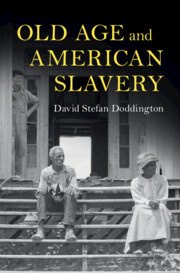Book contents
- Old Age and American Slavery
- Cambridge Studies on the American South
- Old Age and American Slavery
- Copyright page
- Dedication
- Contents
- Figures
- Tables
- Acknowledgments
- Introduction
- Part I The Enslaved
- 1 “As to those more advanced in life”
- 2 “Old and broken now; no tongue can tell how much I suffer”
- 3 “Young people think that old people are fools but old people know that young people are fools”
- 4 “Don’t kill such an old creature as I”
- 5 “You wont notice me now but you’ll wish you had”
- 6 “The summer of my life was passing away”
- Part II Enslavers
- Bibliography
- Index
5 - “You wont notice me now but you’ll wish you had”
Conjure, Community, and Intergenerational Conflict
from Part I - The Enslaved
Published online by Cambridge University Press: 27 October 2023
- Old Age and American Slavery
- Cambridge Studies on the American South
- Old Age and American Slavery
- Copyright page
- Dedication
- Contents
- Figures
- Tables
- Acknowledgments
- Introduction
- Part I The Enslaved
- 1 “As to those more advanced in life”
- 2 “Old and broken now; no tongue can tell how much I suffer”
- 3 “Young people think that old people are fools but old people know that young people are fools”
- 4 “Don’t kill such an old creature as I”
- 5 “You wont notice me now but you’ll wish you had”
- 6 “The summer of my life was passing away”
- Part II Enslavers
- Bibliography
- Index
Summary
This chapter moves from physical contests to consider those who took alternative routes toward enforcing the respect they believed was owed to them in old age. Rather than rely on physical force, some elders wielded the cultural and spiritual force associated with conjuration, hoodoo, and root-work to solicit respect, even fear, from others in the community. This was a route available to enslaved women and men, and this chapter moves beyond the gendered dimensions of physical competition and age to address wider generational power dynamics in community life. Conflict presented in the context of conjure offers another window into – and reveals the significance of – intergenerational strife among the enslaved, and shows how age operated as a contested relation of power that ran alongside, but sometimes superseded, gendered beliefs relating to power and authority. The chapter shows the existence of multiple, sometimes conflicting belief systems that were understood as marked by generational differences, as well as the impact of this for notions of solidarity among the enslaved.
Keywords
- Type
- Chapter
- Information
- Old Age and American Slavery , pp. 164 - 194Publisher: Cambridge University PressPrint publication year: 2023

